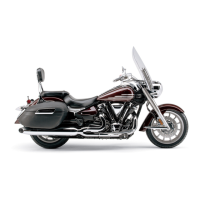
Do you have a question about the Yamaha STRATOLINER XV19CTSC and is the answer not in the manual?
| Brand | Yamaha |
|---|---|
| Model | STRATOLINER XV19CTSC |
| Category | Motorcycle |
| Language | English |
Warns to read the manual and riding tips booklet before operating the motorcycle.
Outlines operator responsibilities like training, observing manuals, and seeking technical service.
Covers pre-operation checks, conspicuousness, and caution at intersections.
Advices riding where visible, avoiding blind spots, and knowing skills/limits.
Details rules like obeying speed limits, signaling, and proper posture.
Emphasizes helmets, eye protection, jackets, boots, and gloves for safety.
Warns against unauthorized modifications and advises on safe cargo loading.
Provides guidelines for cargo loading and selecting accessories for safety.
Details specific warnings and information found on various labels.
Identifies clutch lever, handlebar switches, meter unit, and brake lever.
Details the functions of the main switch and how to lock the steering.
Details the meaning of lights like neutral, high beam, turn signals, and warning lights.
Describes the engine trouble warning light and its conditions.
Explains the speedometer, fuel gauge, odometer, tripmeters, and clock functions.
Details the function of the speedometer and tachometer, including the red zone caution.
Describes the fuel gauge operation and how to use odometer and trip meter modes.
Details the dimmer, turn signal, and horn switches on the left handlebar.
Specifies premium unleaded gasoline and warnings about gasohol.
Highlights the owner's responsibility and the importance of pre-operation inspections.
Warns about familiarization with controls, ventilation, and sidestand position.
Details the steps and conditions required to start the engine safely.
Details the gear shifting process, including cautions for coasting and clutch use.
Explains the importance of the break-in period and recommended engine speed limits.
Highlights the role of periodic maintenance in ensuring safety and performance.
Warns that unapproved modifications can compromise safety and performance.
Outlines periodic checks and replacements for emission control system parts.
Provides a chart for general maintenance tasks like checking air filters, brakes, tires, and bearings.
Covers maintenance for swingarm, drive belt, steering, chassis fasteners, and suspension parts.
Details maintenance for shock absorbers, engine oil, filters, transfer case oil, and electrical components.
Explains fluid changes, oil seal replacement, and hose replacement for brake/clutch systems.
Explains how to check spark plug condition, gap, and when to replace them.
Provides instructions on how to check the engine oil level correctly.
Explains the process for changing engine oil and replacing the oil filter cartridge.
Details tire air pressure settings, inspection for wear, and impact of loading.
Specifies minimum tread depth and when to replace tires.
Details how to check brake and clutch fluid levels and important precautions.
Describes the sealed battery and provides crucial safety warnings about electrolyte.
Details the process for replacing fuses, including warnings about amperage.
Introduces the troubleshooting chart and advises on using genuine parts.
Provides a chart to diagnose issues related to fuel, compression, ignition, and battery.
Outlines the limited warranty period, exclusions, and customer responsibilities.
Details the warranty coverage for the vehicle's emission control system.